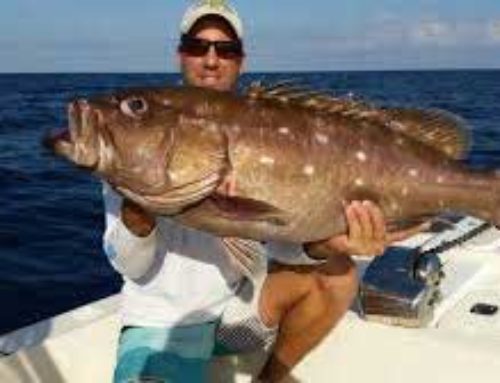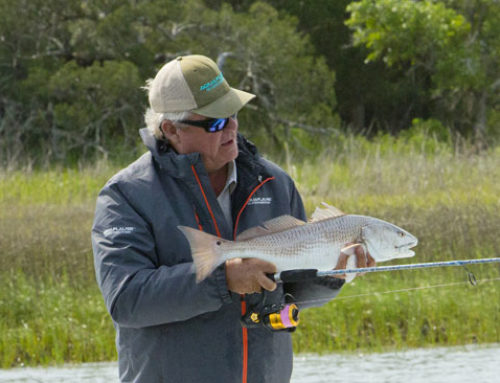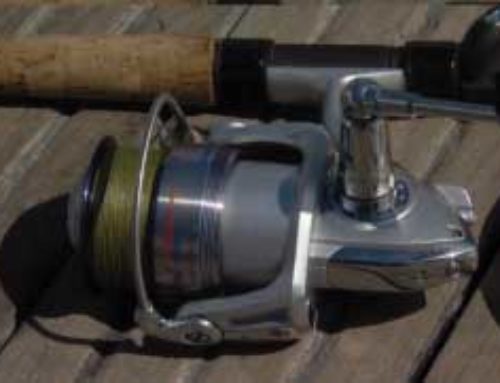If you use crimped connections in monofilament line or leader, you may be in for a shock. When I started using mono instead of wire for my trolling leaders almost 30 years ago, I tested some mono against wire to see which was stronger. What I discovered went beyond the arguments about which leader material to use; my tests revealed how difficult it is to make good crimped connections.
When I tested several brands of line and a variety of sleeves and crimping tools, what appeared to be good, solid connections failed at a mere 40 percent of the leader’s breaking strength. Recently, I did more extensive testing, which proved even further just how precise you must be to make the perfect crimp.
How important is that? If your leader is much heavier than your line, even a 40-percent crimp may be good enough. The line usually will break before the leader snaps or the crimp fails. However, when mates wire a fish at the boat and greater strain is placed on the leader, that crimp connection becomes more vital. Similarly, if you lighten up on your terminal tackle for leader-shy fish, anything less than a 90-percent crimp may mean an instant break-off.
Hold Tight and Pull
In 1975, Capt. Jim Hunter and I sat down at his house in Kona, Hawaii, with a six-pack of beer, a small stainless-steel shackle, a metal ring about 2 inches in diameter and a huge screwdriver. We also had coils of 250- and 300-pound-test monofilament leader and a variety of sleeves. Our crimping tool was an old one, the one-size-fits-all type with a semicircular notch in one jaw and a blade on the other, which compressed the sleeve around two strands of line.
We sat on Hunter’s floor and anchored our leader at the base of a wall to test a variety of crimped connections. With straight legs and back, we could pull hard enough to break the 300-pound leader and even some 0.035-inch-diameter wire — both stainless-steel (240-pound test) and tinned music wire (330- to 350-pound test). We used the large screwdriver as a handle to pull on a loop in the leader material. (Pulling with the leader wrapped around gloved hands was too painful to make multiple tests!)
We never knew the exact breaking strength in pounds, but we could generate some conclusions by how hard we strained to break the test sample. We could compare two different sleeve sizes, our individual crimping techniques, or even the strength of piano wire versus monofilament. We attached pieces of each leader to the metal ring and pulled at opposite ends.
The simplest test involved crimping a loop at either end of a 2-foot piece of mono. We shackled one loop to the wall and pulled on the other loop with the screwdriver until something gave way.
Our comparison test demonstrated three outcomes:
- A sleeve would slip, and the line would either slide free or would slide and then break because the sleeve was not crimped tightly enough.
- The line would break inside one of the sleeves because it was overcrimped.
- The line would break outside the sleeves, indicating two perfect crimps.
Hunter and I used the same crimping tool, but for several hours Hunter’s crimping technique beat me every time. ”You have to squeeze until [the crimp] feels hard, but not too hard or the line breaks inside the sleeve where it gets damaged,” he would tell me.
Hunter would occasionally achieve the perfect crimp, but I never really did. Especially in the beginning, mine either slipped or broke in the crimp. Once I began to get the feel for how hard to squeeze the crimping tool, it took a lot more strain to break the line. But getting a feel for proper crimping pressure is not something quickly and easily taught to a new mate.
One Size Does Not Fit All
Several years later, I spent a number of hours in a commercial-fishing supply store tuning several new crimping tools — the green-handled type commonly used today that features three different-sized holes formed by the closed jaws. These tools are sold virtually everywhere; they’re made by just a handful of international companies, but marketed under a variety of names in the United States.
I found alarming results. Anglers may presume these tools can create secure connections in multiple sizes of line, but they’re wrong. I could get each tool to make perfect crimps for only one size of relatively small mono — without retuning the tool. The sleeve also had to be matched to the exact brand and breaking strength of the line; what seemed to count most was matching the diameter of mono to sleeve. However, once these adjustments were considered, anyone with sufficient hand strength could make perfect crimps.
I noted that slightly under-crimping a sleeve led to a stronger connection, though the line eventually slipped through the sleeve. Over-crimping caused the line to break inside the sleeve under less strain. Comparing the strain placed on the connection with the compressive force — or how tightly the tool was adjusted — followed an almost perfect wave curve.
With low compressive force, the crimped loop would resist only a slight strain before the line slipped from the sleeve. As compressive force increased, the strain needed to cause line slippage increased. Eventually, the line slipped slightly, then broke inside the sleeve.
In a fishing situation, an angler might not be able to differentiate a slip-and-break from a clean line break or even from an over-crimped sleeve that broke inside the sleeve without ever slipping. As figure 1 clearly shows, there is only a small margin of error between the compressive force used to make a perfect crimp and the force used in an over-crimp situation.
Bench Is Best
To produce hard numbers to go with my memories of earlier tests, I visited the Pompano Beach, Florida, offices of Hi-Liner Fishing Gear and Tackle earlier this year. Hi-Liner supplies the Momoi nylon monofilament I use for marlin leaders, and they have a range of crimping tools as well as two huge line-testing machines.
Our best results came from testing Momoi Hi Catch with a stated breaking strength of 400 pounds. The line had a very consistent diameter of 2.05 mm (measured with a micrometer), and straight pieces of line broke consistently at 500 pounds, with one low of 490 pounds and one high of 510 pounds. The dry-tested strength was 25 percent higher than the stated strength.
Of the five crimping tools we used — hand tools and bench tools ranging in price from $35 to $450 — only one created consistently perfect breaks. That large, Japanese-made bench tool, with a series of replaceable jaws or dies, is marketed by Hi-Liner as a Momoi Bench Tool at a retail price of $450. The tool’s dies were glued into place to benefit a commercial boat or tackle shop that works with only one size of line at a time.
We made a crimped loop in one end of our test line that we fastened to a welded, stainless-steel ring or a swivel attached to a piece of heavy cable at the base of the testing machine. The tag end of the line was held fast in the machine’s vise. We deliberately started the testing with connections that were too lightly crimped, and in all our first tests the line slipped through the sleeve.
In one typical test series, the first crimped connection broke at a mere 280 pounds after slipping substantially. After each test, we tightened the tool’s set-screw adjustment approximately one-eighth of a turn. The line continued to either slip free or slip and then break under increasing strain: 410, 460, 470 and 490 pounds. After the line slipped at 490 pounds, we made another one-eighth adjustment, and the line broke inside the crimp at 430 pounds. With an additional one-eighth adjustment, the line broke at only 270 pounds. We backed off a quarter-turn and after a couple more fine-tuning adjustments to the set screw, the line almost always broke outside the crimp.
Slightly under-crimping proved much more desirable than over-crimping, yet the fear of a crimp slipping is extreme, and for most captains and deckhands it’s an unforgivable sin! If a leader breaks and the fish escapes with the hook and crimped sleeve, there’s no way to know what caused the failure. Often the line or leader is criticized as being bad when, in truth, overzealous crimping by a strong young mate has robbed the material of half its potential strength.
A second bench tool we used was Korean-made and marketed by Hi-Liner as the Hi-Liner Bench Tool; it retails for $265. This tool featured dies secured by removable pins, allowing users to quickly change jaw sizes. The Hi-Liner Bench Tool provided consistently strong connections, but perhaps because of the slight play in the pinned dies, we could not get the same number of perfect crimps as with the previous bench tool.
We easily achieved connections that held at 90 percent of the line’s breaking strength with only a few adjustments, even after changing jaws with the Hi-Liner Bench Tool. Using hand tools to crimp the same mono and sleeves, we found that connections slipped or broke in a range from 40 to 75 percent of the line’s breaking strength.
Lighter Leader Options
Tuna fishermen may tend to try ”shy” gear to get bites from the keen-eyed species they target. By using smaller, less visible leader, they often get bites when stronger, more obvious terminal gear is rejected. With lighter line, creating maximum-strength connections is paramount. Circle hooks, which almost always catch in the corner of a tuna’s jaw, prevent the chafing problems common to J-hooks, and light leader can be used if the connections are strong enough.
A small, green-handled crimping tool made by a Japanese company and marketed by Hi-Liner as a Momoi Mini Press can be tuned with a simple adjustment to a set-screw inside the handles to provide perfect crimps for lighter leaders. (Again, the tool must be adjusted anytime you change line or sleeve size.) Retail cost for the tools is $45, and anglers can tune them themselves to use on mono leader up to about 250 pounds.
We made multiple tests using Momoi Diamond Line with a diameter of 1.28 mm and a stated strength of 130 pounds, which actually broke at 240 to 260 pounds. Our first tests used a series of hand tools and L-mini sleeves, which had a 1.3-mm internal diameter and were 2.6 mm long.
Results ranged from only 16 pounds to 179 pounds with the different hand tools. Even with the adjustable green tool, the strongest connection we achieved failed at 179 pounds — less than 72 percent of the tested breaking strength.
We tried double-crimping with two mini sleeves; the line slipped at 192 and 215 pounds and broke at 192 pounds inside the sleeve. I commonly use two sleeves when rigging baits for small billfish on light tackle, especially when I’m not on my boat and am nervous about the crimp size and the crimping tool available.
With a Momoi H sleeve that had the same inside diameter as the L-mini sleeve but that was slightly longer and had what appeared to be thicker walls, everything changed. We achieved perfect breaks outside the sleeve at 250 pounds using the green adjustable tool.
With a blue-handled Momoi Mini Press with Line Cutter, we were also able to make perfect breaks using the center hole by squeezing the tip of the jaws completely closed. This tool was built exactly right for this one combination — Momoi Diamond Line 130-pound class and the L sleeve.
The final tool, and one I see frequently on sport-fishing boats, is a large, powerful-looking hand tool also made in Korea. Mine has the designation CH-18 on the crossbar. It has a course-thread set-screw adjustment, which allows it to be tuned to some degree, but there is no locking nut to keep the adjustment screw in place. The crew at Hi Liner used a stack of washers to lock their tool for one particular size of leader and achieved perfect breaks in that specific line size. We found consistent breaks with this tool near the stated 400-pound strength of the leader, which is more than most deckhands can stand.
Crimps still out tested knots, especially on heavier monofilament. Using the 130-pound Diamond Line (that actually broke at 260 pounds) in a dry test, our best knot — the doubled clinch knot — broke at 150 pounds for a 40-percent loss of strength. Other knots tested even lower, down to 85 pounds for a three-turn uniknot, a mere 30 percent of the potential breaking strength.
How Strong is Strong Enough?
For billfish anglers and crew, it may not be terribly important to get 100-percent-perfect crimped connections. We commonly use monofilament nylon leaders quite a bit stronger than really necessary to capture the size fish we’re targeting, primarily to allow for chafing the billfish’s rough bill and jaws cause.
Sailfish and marlin both have raspy denticles (Latin for ”little teeth”) covering their bills and jaws that can wear away enough leader material to drastically weaken nylon monofilament leaders. When simply pulling against a fish with his gloved hands causes a mate to break a leader that can test over 500 pounds, it’s most often because of chafing, not because the crimped connection tested to only 350 pounds. The heavier the fishing line used and the heavier the drag setting, the faster the leader will abrade.
Really large blue and black marlin can easily cut heavy monofilament if they take in a bait or lure deeply on the strike. The corners of their jaws can pinch off the leader like scissors. I have had it happen myself and have even heard of a big Madeira blue marlin leaving the line in the outrigger after it crashed a lure and pinched off the leader. I now usually use a short section of stainless cable on lures for BIG marlin.
Leave off the Loops
Some crews don’t simply thread the leader straight through the eye of a circle hook; they either loop the line once around the shank of the hook or twice around to make a ”stiff-hook” rig, because they believe it increases the hookup rate. This can be a fatal flaw if there is not sufficient slack to allow the sleeve to completely clear the eye of the hook. If the sleeve is tight against the eye, leverage can reduce the strength of the connection dramatically.
Looping around the hook can also diminish the connection strength if — and this is a big ”if” — the hook’s shank and the area outside the eye are not completely smooth. A slight flaw on the welded eye of one hook lowered the breaking point of one leader we recently tested from 500 pounds to 190 pounds. Other tests broke at 450 and 210 pounds. We achieved a full-strength break only once during our tests, even with a perfectly tuned tool.
The stiff-rig figure-8 wrap was most likely to lower the strength of the connection because it did not pull evenly on both pieces of line exiting the crimped sleeve.
Pulling the sleeve tight against a stainless-steel thimble before crimping it can severely impair the connection. When an aluminum sleeve is crimped, the soft metal has to move somewhere — just like toothpaste oozing from both ends of a tube being squeezed in the middle. Crimping will push the thimble away from the end of the sleeve, putting enormous tension on the line going around the thimble. Even a small amount of pull on the main leader is enough to cause a ”crotch break” when added to the strain of the sleeve against the mono loop.
For more information write to:
Hi-Liner Fishing Gear and Tackle Inc.
3529 Enterprise Way
Green Cove Springs, Florida 32043
800-525-GEAR or 954-783-1320
fax 954-941-9329
or visit www.hiliner.com





